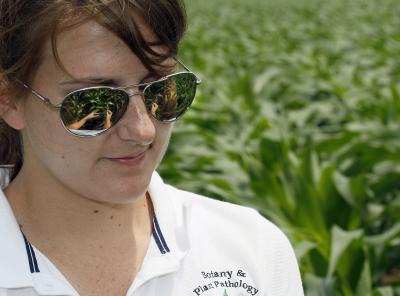WEST LAFAYETTE, Ind. - Unless a corn crop is at risk of developing fungal diseases, a Purdue University study shows that farmers would be smart to skip fungicide treatments that promise increased yields.
Kiersten Wise, an assistant professor of botany and plant pathology, said fungicides used in fields where conditions were optimal for fungal diseases improved yields and paid for themselves. In fields where fungal diseases are unlikely to develop, however, applying a fungicide is likely a waste of money.
"About five years ago, we never used fungicides in hybrid corn. Then there was this push to use fungicides for yield enhancement, even without disease problems," said Wise, who collaborated on findings that were published as an American Phytopathological Society feature article in the journal Phytopathology. "We found that you would have to get a substantial yield increase for a fungicide treatment to pay for itself. We didn't see that yield increase on a consistent basis, and it wasn't predictable."
Wise and her collaborators reviewed published data from foliar fungicide tests in 14 states, as well as data from their own research plots, to determine which circumstances led to yield increases when fungicides were used. They found that a combination of several factors that would contribute to fungal disease - no-till fields, fungus-susceptible hybrids, continuous corn, wet field conditions, etc. - needed to be present for yields to increase with fungicide applications.
"In our trials, even where conditions were optimal for disease, if disease didn't develop, we didn't see a yield increase," Wise said.

Kiersten Wise's research shows that fungicide use on corn without the presence of disease does not produce higher yields.
(Photo Credit: Purdue Agricultural Communication photo/Tom Campbell)
Growers need to weigh the cost of the treatments - usually $32-$34 per acre - against the possible benefits and the price of corn. At low corn prices, it takes a larger yield increase to recoup the cost of a fungicide application.
Wise said the general rule was that growers needed to see a yield increase of about six bushels per acre to recover their investment.
Wise collaborated with researchers from Iowa State University, University of Illinois, University of Minnesota, Mississippi State University, University of Maryland, University of Kentucky, University of Wisconsin, and the Ohio Agricultural Research and Development Center.
Wise said she would continue research to determine more specific guidelines for when fungicide applications increase profits. The Indiana Corn Marketing Council funded the work.
Source: Purdue University